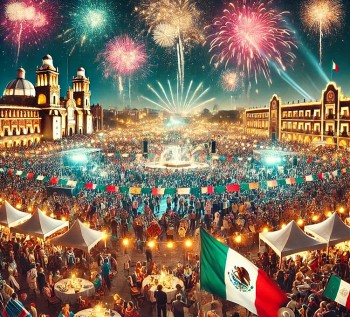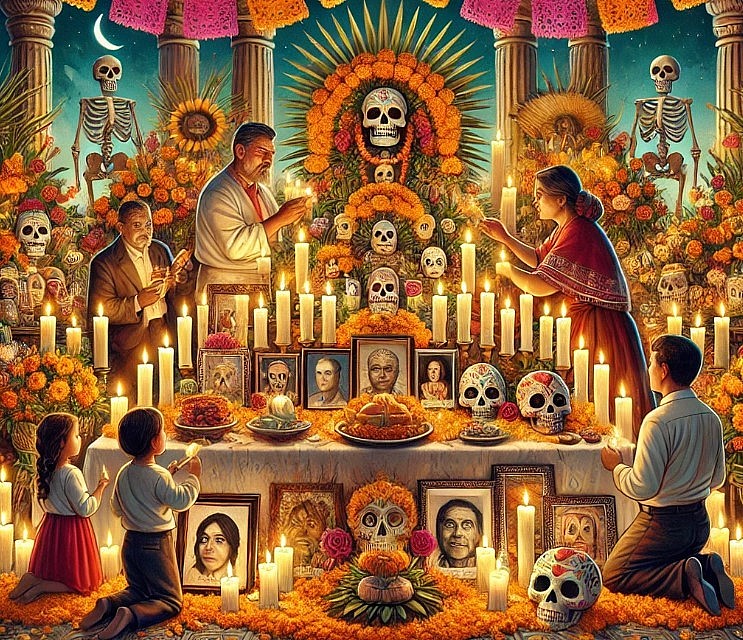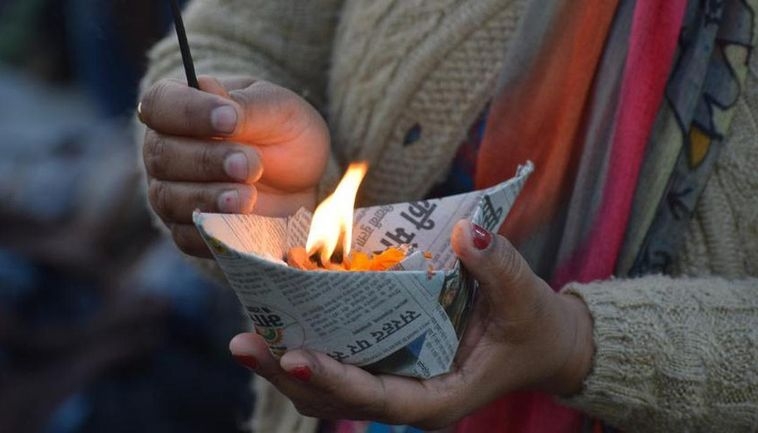Day of the Dead: Origins, Significance, Traditional Customs and Rituals
| Table of Contents |
Far from being a somber occasion, this holiday is filled with color, joy, and heartfelt tributes to loved ones who have passed. Families across Mexico come together to honor their ancestors by creating beautiful altars, decorating graves with marigolds, and sharing the favorite foods of those they remember. This vibrant celebration views death not as an end, but as a continuation of life, maintaining a connection between the living and those who have departed.
Día de los Muertos has become a powerful expression of Mexican culture, embodying themes of family, memory, and the cycle of life. Today, it is recognized around the world as a unique and beautiful way to remember and celebrate the lives of loved ones, making it not only a national holiday but also a cultural symbol admired globally.
Learn more: Top 10 Most Popular Holidays in November Around the World
 |
| A Día de los Muertos cemetery gathering at night, with families honoring loved ones around decorated graves, surrounded by candles and marigold petals |
Origins and Historical Background
Día de los Muertos has ancient roots that trace back to the indigenous cultures of Mesoamerica, including the Aztec, Toltec, and other pre-Columbian societies. These civilizations held complex views on life and death, often viewing death as a natural phase of existence rather than something to be feared. The Aztecs, in particular, believed in an afterlife where the spirits of the dead continued their journey, with rituals held to honor the deceased as part of maintaining balance in the cosmos.
For the Aztecs, death was celebrated during a month-long festival dedicated to Mictecacihuatl, the goddess of the underworld, known as the "Lady of the Dead." Offerings were made to honor and support the spirits on their journey, a custom that has influenced the modern traditions seen in Día de los Muertos.
When Spanish conquistadors arrived in Mexico in the 16th century, they introduced Catholic practices and holidays, including All Saints’ Day and All Souls’ Day. Over time, indigenous beliefs merged with Catholic traditions, evolving into the Día de los Muertos celebrated today. The resulting holiday is an intriguing blend of ancient Mesoamerican customs and Catholic observances, celebrated with altars, offerings, and rituals that reflect both the heritage of Mexico’s indigenous people and the influence of European colonization.
Cultural Significance and Philosophy
The philosophy behind Día de los Muertos is rooted in a unique perspective on death, viewing it as a natural part of the human experience rather than something to mourn. In Mexican culture, death is not seen as an abrupt end but as a continuation of life in a different form. Día de los Muertos embodies this view by treating death as an occasion to celebrate, remember, and honor loved ones.
Family is at the heart of the holiday. By creating altars and gathering to remember deceased family members, Mexicans maintain a strong sense of connection to their ancestors, honoring the legacies passed down through generations. This familial focus extends beyond immediate family to include distant relatives and even beloved pets, showing how deeply the holiday embraces the concept of family unity and continuity.
Several symbols are central to Día de los Muertos, each carrying unique meanings. Marigolds, known as cempasúchil, are said to guide spirits back to the world of the living with their bright colors and strong fragrance. The calavera (skull) has also become an iconic symbol, often represented as decorated sugar skulls placed on altars or as face paint in parades. The skulls serve as a reminder of the cycle of life and the acceptance of death as part of existence. Traditional foods like pan de muerto, a special bread adorned with bone-shaped decorations, symbolize the cycle of life and death and are enjoyed by families as part of the celebration.
 Mexico Calendar 2025 - List of Public Holidays, Observances, And Celebrations Mexico Calendar 2025 - List of Public Holidays, Observances, And Celebrations |
Traditional Customs and Rituals
 |
| A traditional Día de los Muertos altar (ofrenda), with family members gathered around, placing items and lighting candles |
Día de los Muertos is celebrated through various customs that each play a role in creating a vibrant, respectful atmosphere. Here are some of the most important traditions that make this holiday both meaningful and memorable:
-
Creating Ofrendas (Altars): The ofrenda is perhaps the most recognized aspect of Día de los Muertos. These altars are set up in homes, cemeteries, or public spaces and are carefully decorated with items meant to welcome and honor the spirits of the deceased. Common items include marigolds, candles, photographs of the deceased, sugar skulls, and personal mementos. Each part of the ofrenda has meaning: candles represent light guiding the spirits, water refreshes them after their long journey, and salt purifies the soul.
-
Cemetery Visits: On Día de los Muertos, families often visit cemeteries where their loved ones are buried. They clean and decorate the graves with marigolds, candles, and offerings of food and drink. In many communities, families spend the night at the cemetery, sharing stories, playing music, and keeping vigil as a sign of respect and remembrance. This gathering in cemeteries is a time for families to reconnect and remember those who have passed, creating a sense of unity and continuity with their ancestors.
-
Food and Music: Food plays a central role in Día de los Muertos, with families preparing the favorite dishes of the deceased to place on altars and enjoy together. Pan de muerto, a sweet bread topped with sugar and often decorated with shapes resembling bones, is a common treat during the holiday. Music and dance are also important elements, with live performances held in many communities to honor the spirits. In some areas, mariachi bands or traditional folk musicians play at the gravesites, creating an atmosphere of celebration rather than mourning.
-
Parades and Public Celebrations: In recent years, Día de los Muertos parades have gained popularity, particularly the one held in Mexico City, which was inspired by a scene from the James Bond movie Spectre. These parades feature elaborate costumes, floats, and calavera face paint, showcasing the holiday’s themes of life, death, and cultural pride. Such public celebrations have turned Día de los Muertos into a vibrant, accessible holiday that draws both locals and tourists.
Global Influence and Recognition
Día de los Muertos has grown beyond Mexico’s borders, gaining recognition and admiration worldwide. In the United States, where Mexican-American communities celebrate the holiday, Día de los Muertos has become widely appreciated and is celebrated with public festivals, art exhibitions, and community events. Cities like Los Angeles, San Antonio, and Tucson host large-scale events that attract people from all backgrounds, highlighting the universal appeal of honoring loved ones.
Hollywood has also played a role in popularizing the holiday. The Disney-Pixar film Coco (2017) brought Día de los Muertos to the forefront of global consciousness, introducing its themes of family, memory, and legacy to audiences around the world. Coco was widely praised for its respectful portrayal of Mexican culture and the holiday’s significance, leading to a surge in interest in Día de los Muertos celebrations outside Mexico.
Today, Día de los Muertos is recognized as a symbol of Mexican identity and resilience. The holiday showcases the strength of family bonds, the importance of cultural heritage, and the acceptance of death as a natural part of life. As it continues to gain popularity globally, Día de los Muertos provides a valuable opportunity for cross-cultural understanding and appreciation.
Conclusion
Día de los Muertos is much more than a holiday; it is a celebration of life, memory, and the enduring bond between the living and the deceased. Through vibrant altars, joyful gatherings, and heartfelt tributes, families across Mexico and beyond honor their loved ones, ensuring that their legacies live on. This beautiful holiday offers a unique perspective on death, seeing it not as something to fear but as a reminder of the preciousness of life and the connections that transcend time.
In today’s fast-paced world, Día de los Muertos stands as a powerful reminder of the importance of family, heritage, and remembrance. Its traditions encourage us to reflect on our own lives, cherish the memories of those we’ve lost, and embrace the joy of life’s journey. As this beloved celebration continues to inspire people worldwide, it remains a testament to the resilience of Mexican culture and the universal desire to honor those who have come before us.
Frequently Asked Questions (FAQ)
-
What is the main purpose of Día de los Muertos?
Día de los Muertos is a celebration of life, death, and remembrance, honoring deceased loved ones by inviting their spirits back to the world of the living. Families set up altars, share stories, and offer food and decorations to celebrate and keep memories alive.
-
How is Día de los Muertos different from Halloween?
While Halloween and Día de los Muertos share similar dates, they are different in purpose and tone. Halloween tends to focus on costumes and spooky themes, while Día de los Muertos is about honoring deceased loved ones in a joyful, reflective way. Día de los Muertos is rooted in Mexican culture and reflects a positive view of death.
-
Why are marigolds used during Día de los Muertos?
Marigolds, known as cempasúchil, are believed to guide spirits back to the world of the living with their bright colors and strong fragrance. Marigold petals are often used to create paths from altars to graves, symbolizing a bridge between worlds.
-
What is an ofrenda?
An ofrenda is an altar set up to honor deceased loved ones, decorated with photos, marigolds, candles, sugar skulls, and the favorite foods and belongings of the departed. It serves as a welcoming space for the spirits and a way for families to remember their loved ones.
-
Is Día de los Muertos celebrated only in Mexico?
While Día de los Muertos originated in Mexico, it is celebrated by Mexican communities worldwide, especially in the United States. Many cities hold public festivals and parades, allowing people of all backgrounds to join in the celebration and learn about the tradition.
-
What foods are commonly associated with Día de los Muertos?
Pan de muerto (bread of the dead) is a traditional sweet bread decorated with shapes representing bones, and it is commonly shared with family and placed on altars. Other foods include tamales, mole, and sugar skulls, as well as the favorite dishes of the deceased family members.
 Top 10 Most Beautiful Mexican Women in 2024/2025 Top 10 Most Beautiful Mexican Women in 2024/2025 Who stands out as the most visually stunning and enchanting Mexican woman of 2024/2025? Keep yourself informed about the latest rankings in Mexican beauty. |
 November 2024 US Calendar: Full List of Holidays and Celebrations November 2024 US Calendar: Full List of Holidays and Celebrations November is an excellent month for both major and minor festivities. Check out full list of November holidays in the US in 2024. |
 Canada Calendar in November 2024: Full List of National Holidays, Special Days and International Events Canada Calendar in November 2024: Full List of National Holidays, Special Days and International Events In Canada, November is a month full of different social, political, and cultural events. All over the country, Canadians come together to celebrate and think ... |
 10 Popular November Holidays & Festivals of The World 10 Popular November Holidays & Festivals of The World People celebrate a variety of joyous holidays in November around the world, in addition to Thanksgiving. The ten most joyous holidays in November are listed ... |
 November Holidays and Observances for Every Year November Holidays and Observances for Every Year November is a month full of international holidays, including Thanksgiving, Hug a Beer Day, Diwali, All Saints Day, and many more monthly, weekly, and daily ... |
























